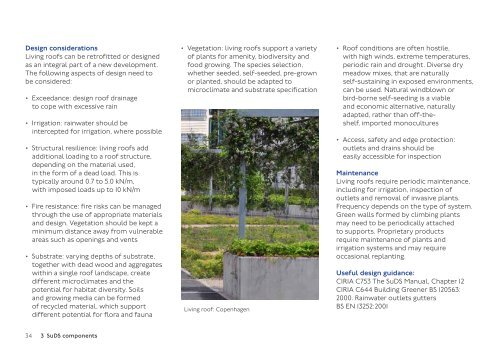SuDS in London - a guide
sustainable-urban-drainage-november-2016
sustainable-urban-drainage-november-2016
You also want an ePaper? Increase the reach of your titles
YUMPU automatically turns print PDFs into web optimized ePapers that Google loves.
Design considerations<br />
Liv<strong>in</strong>g roofs can be retrofitted or designed<br />
as an <strong>in</strong>tegral part of a new development.<br />
The follow<strong>in</strong>g aspects of design need to<br />
be considered:<br />
• Exceedance: design roof dra<strong>in</strong>age<br />
to cope with excessive ra<strong>in</strong><br />
• Irrigation: ra<strong>in</strong>water should be<br />
<strong>in</strong>tercepted for irrigation, where possible<br />
• Structural resilience: liv<strong>in</strong>g roofs add<br />
additional load<strong>in</strong>g to a roof structure,<br />
depend<strong>in</strong>g on the material used,<br />
<strong>in</strong> the form of a dead load. This is<br />
typically around 0.7 to 5.0 kN/m,<br />
with imposed loads up to 10 kN/m<br />
• Fire resistance: fire risks can be managed<br />
through the use of appropriate materials<br />
and design. Vegetation should be kept a<br />
m<strong>in</strong>imum distance away from vulnerable<br />
areas such as open<strong>in</strong>gs and vents<br />
• Substrate: vary<strong>in</strong>g depths of substrate,<br />
together with dead wood and aggregates<br />
with<strong>in</strong> a s<strong>in</strong>gle roof landscape, create<br />
different microclimates and the<br />
potential for habitat diversity. Soils<br />
and grow<strong>in</strong>g media can be formed<br />
of recycled material, which support<br />
different potential for flora and fauna<br />
• Vegetation: liv<strong>in</strong>g roofs support a variety<br />
of plants for amenity, biodiversity and<br />
food grow<strong>in</strong>g. The species selection,<br />
whether seeded, self-seeded, pre-grown<br />
or planted, should be adapted to<br />
microclimate and substrate specification<br />
Liv<strong>in</strong>g roof: Copenhagen<br />
• Roof conditions are often hostile,<br />
with high w<strong>in</strong>ds, extreme temperatures,<br />
periodic ra<strong>in</strong> and drought. Diverse dry<br />
meadow mixes, that are naturally<br />
self-susta<strong>in</strong><strong>in</strong>g <strong>in</strong> exposed environments,<br />
can be used. Natural w<strong>in</strong>dblown or<br />
bird-borne self-seed<strong>in</strong>g is a viable<br />
and economic alternative, naturally<br />
adapted, rather than off-theshelf,<br />
imported monocultures<br />
• Access, safety and edge protection:<br />
outlets and dra<strong>in</strong>s should be<br />
easily accessible for <strong>in</strong>spection<br />
Ma<strong>in</strong>tenance<br />
Liv<strong>in</strong>g roofs require periodic ma<strong>in</strong>tenance,<br />
<strong>in</strong>clud<strong>in</strong>g for irrigation, <strong>in</strong>spection of<br />
outlets and removal of <strong>in</strong>vasive plants.<br />
Frequency depends on the type of system.<br />
Green walls formed by climb<strong>in</strong>g plants<br />
may need to be periodically attached<br />
to supports. Proprietary products<br />
require ma<strong>in</strong>tenance of plants and<br />
irrigation systems and may require<br />
occasional replant<strong>in</strong>g.<br />
Useful design guidance:<br />
CIRIA C753 The <strong>SuDS</strong> Manual, Chapter 12<br />
CIRIA C644 Build<strong>in</strong>g Greener BS 120563:<br />
2000. Ra<strong>in</strong>water outlets gutters<br />
BS EN 13252:2001<br />
34 3 <strong>SuDS</strong> components


